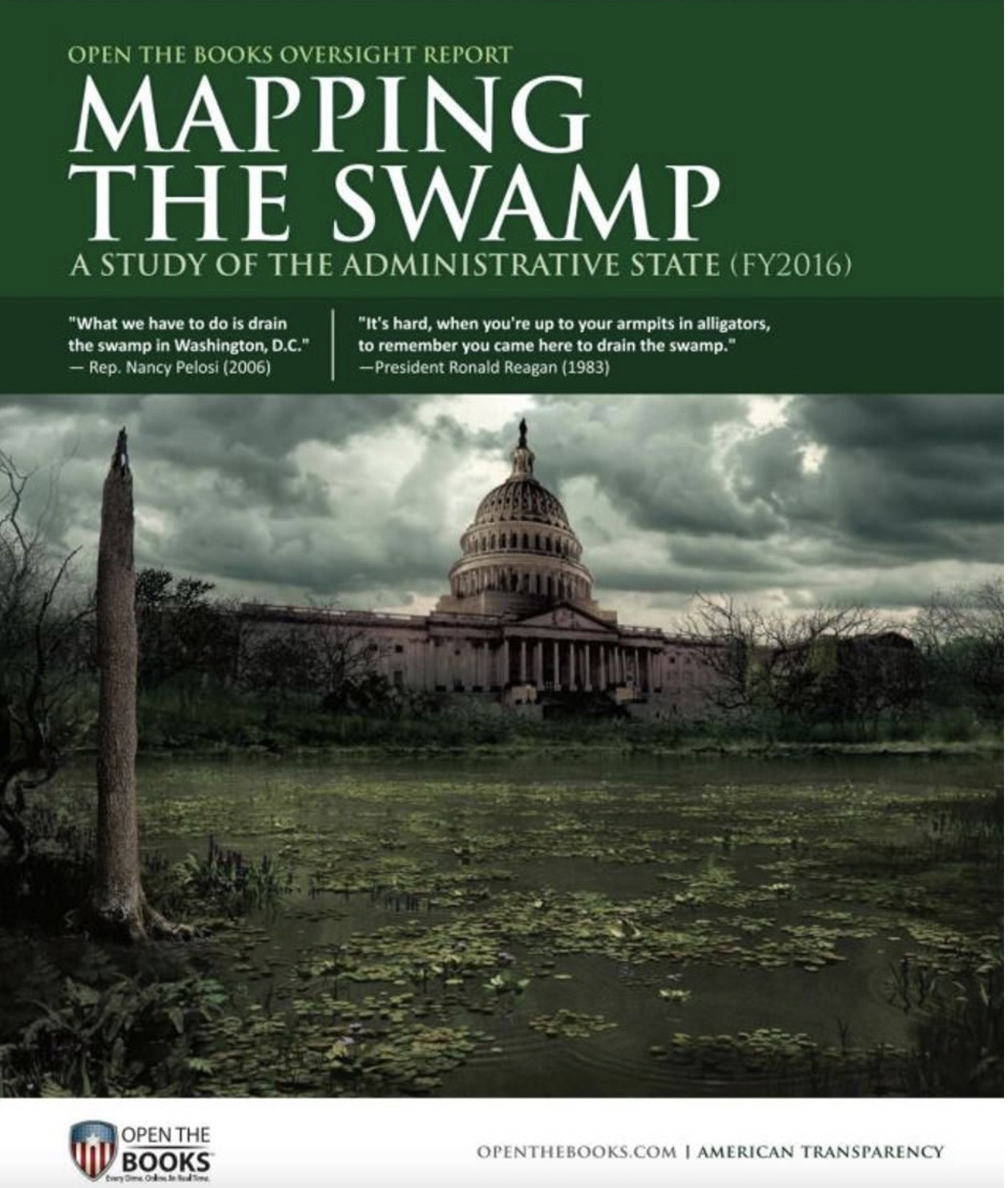Back in December, fiscal transparency organization Open the Books published a massive study of federal government spending which contains a wealth of information and some very disturbing statistics.
Adam Andrzejewski, CEO and Founder of the organization, highlighted some of their key findings in an important Forbes article.
Key excerpts are republished below:
Today’s federal bureaucrats are paid $1.1 million a minute, $66 million an hour, and over $524 million a day – and that’s just the cash compensation cost. Taxpayers also pay for lucrative perks like weeks of paid time-off, performance bonuses and padded retirement pensions.
Using our interactive mapping tool, quickly review the 2 million federal employee salaries and bonuses by ZIP code across America. Just click a pin and scroll down to see the results rendered in the chart beneath the map. See your local piece of the swamp: how much are the federal employees in your backyard earning? Which agency employs them, and what is their job title?
Here are a few of our key findings:
-
- $136 Billion in Cash Compensation – The federal government disclosed 1.97 million employees across 122 independent agencies and departments. In FY2016, these 2 million workers received $136 billion in compensation. If we could factor in another 2 million undisclosed employees – at the Department of Defense and on active military and other agencies – the cost would be much higher.
- $22.6 Billion in Time Off and Benefits – After just three years of public service, federal employees receive ten federal holidays, 13 sick days, and 20 vacation days per year. That is eight and a half weeks of paid time off (43 days per year). That benefit costs taxpayers an estimated $22.6 billion annually.
- $1.5 Billion to Bonuses – The federal government awarded 330,713 bonuses for $351 million (FY2016). However, the federal union agreement bars the disclosure of the $1.1 billion in performance bonuses. So, who received how much? It’s time to open the books on the billion-dollar performance bonuses. The largest federal bonus last year ($141,525) didn’t go to a rocket scientist or a doctor researching a cancer cure; it went to Bart Ferrell, a Human Resources Manager in charge of processing payroll at the Presidio Trust. Ferrell’s total pay last year exceeded $300,000.
- A Six-Figure Minimum Wage? In 78 large agencies, the average employee made more than $100,00. We found 30,000 bureaucrats out-earning every governor of the 50 states with salaries exceeding $190,000. The number of federal employees making $200,000 or more has skyrocketed by 165 percent during the past six years. ‘Diet and Nutrition’ employees can make up to $207,060; ‘Food Services’ workers in the prisons system can bring in $136,622; and ‘Laundry Operations’ employees at the VA can make $101,694. Even ‘photography’ is lucrative, averaging more than $80,000 with top pay reaching $157,971.
- The Administrative State’s Legal Team – We found more than 35,000 lawyers in the federal government, but fewer than 12,000 of them pursue crime and criminals at the Department of Justice. The rest are essentially regulators, sprawled across 94 departments and agencies. These lawyers are pricey, costing taxpayers $4.8 billion. On average, each federal lawyer earned a salary of $136,006 – and including benefits – cost the American taxpayer $175,000 apiece.
- The Administrative State’s Department of Self-Promotion – In FY2016, 70 departments spent $368 million on more than 3,600 in-house public affairs and marketing employees. On average, these employees made $101,827 each. The Department of Agriculture employed the most public affairs employees with a total of 544. The U.S. Postal Service paid James Cochrane, the chief marketing and sales officer, $250,335. Our investigation revealed another $2 billion spent on contracts with outside public relations firms over an eight-year period.
- The Reason Behind Waiting Lines for Veterans – The Department of Veterans Affairs employs one-fifth of the entire disclosed federal workforce for a total payroll cost of $30 billion, which is more than the entire budget of 16 state governments. Still, sick veterans wait to see a doctor because 92 percent of workers on their payroll aren’t doctors. Over the past five years, the VA added 60,000 new positions to payroll, but less than one in ten were doctors. The bloat at the VA is stunning. For example, the VA employed 171 interior designers costing $50 million over the past four years. The VA facility in Palo Alto, California, employed the most interior designers – nine in total. Palo Alto is the same facility that spent $700,000 on sculptures for blind veterans in 2016.
Then there’s this..
The largest swamp of opacity is the $125 billion in annual federal pension payout. Current law prohibits disclosure, but taxpayers deserve to see all the details. We worked with Congressman Ron DeSantis (FL-6) on the Taxpayer Funded Pension Disclosure Act of 2017 that would open the books on retirement annuities. Wouldn’t you like to know the pension amount of retired IRS boss Lois Lerner?
Nuts.
Download the entire report at the following link: Mapping The Swamp – A Study of the Administrative State.
Open the Books is a nonpartisan, non-profit organization focused on providing transparency in government. I’m pleased to have them as a Liberty Blitzkrieg partner since 2015.
In Liberty,
Michael Krieger
Donate bitcoins: 35DBUbbAQHTqbDaAc5mAaN6BqwA2AxuE7G
Follow me on Twitter.





Have you seen the research by Mark Skidmore at MSU? http://msutoday.msu.edu/news/2017/msu-scholars-find-21-trillion-in-unauthorized-government-spending-defense-department-to-conduct/
In 2015 the Pentagon had unaccounted for spending of $6.5 TRILLION against an annual budget of $122 Billion. It shows how shutting down the government over a $4.1 T budget is a façade.
It’s just a pity we don’t have an equivalent disclosure organisation in the UK.Too many vested interest groups here, right and left, wouldn’t let it happen.Apathy and a short memory span is the greatest enemy for the little people to make any significant societal change.Perhaps we collectively need more suffering before we can act.Thanks for your on going work.
“The Reason Behind Waiting Lines for Veterans” is absolutely Orwellian in every respect.
Now the MIC is complaining that far too many of the young men who enlist in the various branches of the armed forces aren’t in good enough physical shape to get through basic training.
So they are starting a media campaign to encourage young men to “exercise and lose weight for the good of homeland security”. That way they’re healthy enough to be sent off to be maimed and/or killed in a war zone.
Excellent article Mike! Appreciate It!
I am being extrajudicially murdered in a silent civil war.
https://rebel0007com.wordpress.com/2018/01/31/i-am-being-extrajudicially-murdered-in-a-silent-civil-war/
The Governments Have Placed All Information About Their Activities In PDF Form Since the Spring of 2017 – Andrea Iravani
https://rebel0007com.wordpress.com/2018/01/31/the-governments-have-placed-all-information-about-their-activities-in-pdf-form-since-the-spring-of-2017/
Peace,
Andrea Iravani
So, these guys are talking about a potential $160.1 billion misallocation of US federal funds. That’s a lot of money. But it doesn’t come close to mapping out the swamp of federal spending.
I was doing the math myself, but then I found this Pew Research article (http://www.pewresearch.org/fact-tank/2017/04/04/what-does-the-federal-government-spend-your-tax-dollars-on-social-insurance-programs-mostly/) where someone had already done most of it for me. In 2016, the US federal government spent…wait for it…$3.9 TRILLION after collecting $3.3 TRILLION of tax revenue (the ~$160 billion the MtS authors discuss is significantly less than 1% of either total). Of that $3.9 trillion spent, about $2.7 TRILLION went to various entitlement programs (veteran’s benefits, food stamps, unemployment compensation, and the Big Three of Social Security, Medicare, and Medicaid), while another $604 BILLION was officially spent on “defense”.The remaining just under $600 BILLION (about the same amount as total deficit spending that year, the shortfall raised by the US Treasury selling interest-bearing bonds) was spent on little things like federal law enforcement, environmental programs, schools, national parks, inspecting food, keeping an eye on financial markets, paying interest on federal debt already accrued…you get the idea.
Let’s assume for a moment that a warmongering nanny state really is where we all want to live. Even if that’s true, the US government is living beyond its means to the tune of about $600 billion a year (or, put another way, the US feds have to borrow about $1 out of every $6 they currently spend). This borrowing has been going on for a long time, but it can’t go on forever. Sooner or later, some hard decisions are going to have to be made about which programs are going to be kept, and how much (not if) even the ones that are kept are going to have to be cut. And it’s a good bet that the longer we put it off, the harder those decisions are going to be.
Now, if we think living in a warmongering nanny state is one of the indicators that we’re living in a swamp, and we don’t consider swampland prime real-estate, then things are even more complicated. The real issue then becomes addressing why entitlement and military programs basically ARE the budget, rather than questioning why small parts of the federal budget are spent unsustainably, or unfairly. I think this is where a lot of what Mr. Krieger has to say about taking personal responsibility and individually making good, conscious choices comes into play. A lot of US citizens are going to have to change their own actions and expectations before the US federal government is going to change direction.
I’m thinking that if we want to drain the swamp, we’re probably going to have to stop living like alligators.
All great points, Jim.
The most important being, “A lot of US citizens are going to have to change their own actions and expectations before the US federal government is going to change direction.
if we want to drain the swamp, we’re probably going to have to stop living like alligators”.
As dark and negative as it may seem, the only way that is ever going to happen is another collapse of the financial markets. This time with no bailouts for any of the players responsible.
That doesn’t mean TPTB won’t try to enact a 2008 part II screw the commoners strategy, because they definitely will. But the next time the commoners (Alligators) are going to revolt. A “Fool me once, shame on you, fool me twice, shame on me” collective mindset is what will lead to the swamp finally getting drained.
Then it’s time for the virtual guillotines to be employed on the parasites.
It’s collectivism victory and Ayn Rands nightmare. For up-to-day analysis and solutions, also check out this podcasts: https://www.youtube.com/watch?v=njdwj2Ii2Mg